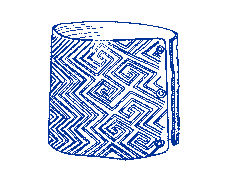The Ancient World created many of the inventions which have contributed to the progress of civilization. Among these are a number which originated in Ukraine. Some of these are noted in a new book Ancient Inventions, by Peter James and Nick Thorpe (New York: Ballantine Books, 1994). In this book review we would like to focus on these inventions which originated in Ukraine according to James and Torpe and include some additional items they missed.
The first horseman rode a horse in Ukraine about 6,000 years ago. James and Thorpe explain it this way: "...the earliest hard evidence for the domestication of the horse dates back only to 4000 B.C. -- teeth of horses from the Copper age site of Dereivka, in southern Ukraine, examined under the microscope show traces of wear caused by having bits in their mouths. These were probably made of rope, as the earliest known metal horse bits date from about 1500 B.C." (p.51).
Pants or trousers, were probably invented about 6,000 years ago by the horsemen on the Steppes of Ukraine. Pants were the typical dress of the Scythian warriors of ancient Scythia-Ukraine 2,600 years ago. Pants are particularly suited to a northern climate and to horsemen which places the logical origin on the steppes or prairies of Eastern Europe, or Ukraine. They are depicted on ancient gold jewelry and vases found in Ukrainian burial mounds (kurgans). Some ancient Greeks, such as Hippocrates, thought poorly of the pants worn by the Ukrainian Scythians. James and Thorpe mention pants were popular among many nations but do not suggest the possible location of the origin of them.
The oldest map in the world, discovered in Ukraine in 1966, is from about 10,000 B.C. Inscribed on a mammoth tusk it was found in Mezhirich, Ukraine. It has been interpreted to show a river with dwellings along a river (p. 57). However, the best claim to the title of "the earliest map in the world" appears on a beautifully engraved silver vase from Maikop in Ukraine, according to James and Thorpe. It was found in a Ukrainian tomb dated at 5,000 years old. It shows two rivers, a mountain range, a lake or sea and wild animals (p. 56-57).
 The oldest known map in the world, discovered by archeologists, is from 12,000 B.C. and was found in Mezhirich, Ukraine. |
 The second map from 3,000 B.C. is from Malikop, Kuban Region which is Ukrainian ethnographic territory but outside Ukraine. From the book Ancient Inventions. |
Cooking is essential to make food palatable. The oldest known primitive, but identifiable, ovens were found in Ukraine and date from 20,000 B.C. (p. 302). James and Thorpe mention in passing on p. 328 that "the first of the famous Viennese coffee houses was opened in 1683, using sacks of coffee left behind by the Ottoman Turks after their unsuccessful siege of Vienna in that year." What they don't mention is that the sacks were given as a reward to the hero of Vienna, the Ukrainian Cossack Georg Kolschitzky (Yuri Kulchytsky), who opened the Blue Bottle Coffee House on Singerstrasse in Vienna.
The oldest known house in the world is a remarkable dwelling found at Mezhirich, near Kiev, the capital of Ukraine. It was found in 1965 by a Ukrainian farmer who was digging a new cellar six feet below his home. It is made of mammoth bones and was built about 15,000 years ago. It formed part of a village and was so strongly built that it would have lasted several generations. This would indicate that the inhabitants were settled agriculturalists rather than nomad hunters. In Kostienki, Ukraine, there was a huge house from the same period which measured 115 feet by 50 feet with elevn hearths for cooking, warmth and light (p. 434-35).
The earliest known musical instruments, according to some scholars also were found in Mezhirich. They were made of decorated mammoth bones. A mammoth skull was used as a kind of drum-like instrument. The Scythians of Ukraine some 2,500 years ago used the bones of eagles and vultures to make excellent flutes.
Jewelry was used by the Stone Age hunters of Europe and Asia by 30,000 B.C. A bracelet carved from a single piece of mammoth ivory found at Mezin, Ukraine (not southern Russia as James and Thorpe say) has a magnificent design which can be found to this day in the embroidery of Ukrainian costumes and cloths. This bracelet dates from about 20,000 B.C. and the design is reminiscent of, but predates, the famous Greek meander (p. 283).
 Bracelet of mammoth ivory tusk from 20,000 B.C. found in Ukraine. The design is still used in Ukrainian embroidery today. |
Although the Romans were ignorant of soap as a cleanser until 2nd century A.D. the Scythians of Ukraine probably as early as the 7th century B.C. were using soap to wash their hair according to the Greek historian Herodotus.
It might be mentioned that wine making probably originated about 5,000 years ago just 200 miles southest of Ukraine in the Caucasus, possibly Georgia, according to James and Thorpe (p. 328-29). So wine has probably been in Ukraine from the very earliest time.
The Scythians of Ukraine shocked the Greeks and Romans because they drank their wine full strength, straight and not mixed with water in the Greek tradition. The ancient Greeks had a saying "drinking the Scythian way" which was to drink wine straight. James and Thorpe seem to be unaware that ancient Scythia was located only in Ukraine not in Russia so they are in error to call the Scythians "ancient Russian people" (p. 331). Incidentally, we use the term Ukrainian Scythians to dinstinguish them from the culturally related Asian Pazyryk people in Siberia who were also called Scythians.
The Scythians were described by Herodotus 2,500 years ago as having small tents which served as vapor baths or saunas. However, the Scythians also improved their vapor steam baths by burning cannabis (marijuana or hashish) on hot stones so they got high along with their steam bath. Herotodus said innocently, "The Scythians enjoy it so much that they howl with pleasure." He said that the Scythian vapor bath of Ukraine gave off "a vapor unsurpassed by any vapor bath one could find in Greece" (p. 448).
Trajan's Column in Rome, built about 115 A.D., has a figure of an armored cavalryman, whose horse also has chain armor. He is probably a Sarmatian from Ukraine although James and Thorpe mistakenly say he is from southern Russia (p. 211).
Greek Fire was a kind of flamethrower weapon. The fleet of King Ihor (or Igor) of Kiev encountered Greek Fire during his 941 A.D. invasion of Byzantium according to the RUS (not Russian) chronicler in the Primary Chronicle. The Chronicler wrote: "The Greeks possess something like the lightning in the heavens and they released it and burned us. For this reason we did not conquer them." However, according to tradition, King Oleh in 907 A.D. did mount his shield on the Gates of mighty Constantinople.
 Gold vase with Scythian stringing his bow, probably Scythes, son of Hercules, who is successful and becomes King of Scythia on the territory of Ukraine. |
One military invention not mentioned by James and Thorpe was the short bow invented by the Ukrainian Scythians which was designed especially for use on a horse. A Scythian could gallop on his horse and shoot back a dozen arrows a minute at a pursuing enemy which is a feat impossible with an ordinary bow. The Scythian bow was short with the ends curled forward. It has come down to the present day as the bow of Cupid who uses it to shoot his arrows of love.
 Cupid uses the Scythian bow from Ukraine to shoot his arrows of love (New York Times). |
The authors Peter James and Nick Thorpe are English scholars and specialists in ancient history and archeology. Overall Ancient Inventions is an excelllent book with fascinating information. Although we have concentrated on the Ukrainian aspects of the book this is only a very small part of the work. The book, which we highly recommend, gives us renewed respect for the genius of the ancient peoples and it provides "a wonderful celebration of the endless inventiveness of the human mind." A.G.
![]() Are you interested in purchasing this book? Please see the
InfoUkes Bookstore.
Are you interested in purchasing this book? Please see the
InfoUkes Bookstore.
|
|
History Television Approved Site |
![]() Return to FORUM: A Ukrainian Review Page
Return to FORUM: A Ukrainian Review Page
Copyright © 1994 Andrew Gregorovich